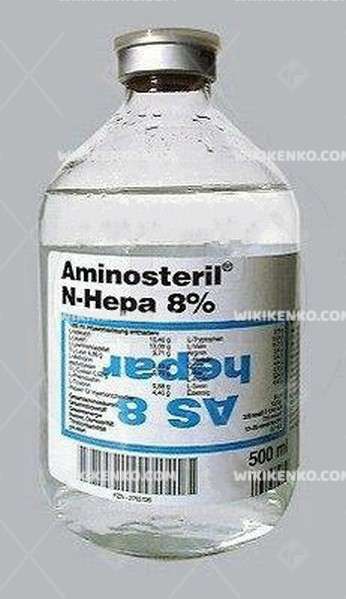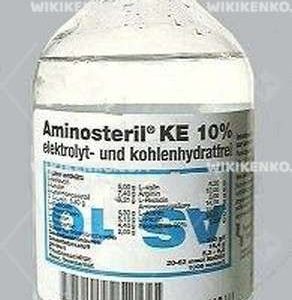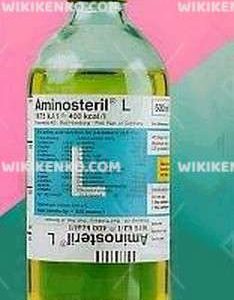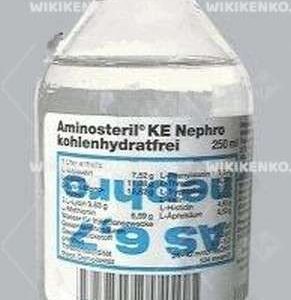Aminosteril N-Hepa
Aminosteril N-Hepa 8% is a vital solution utilized in parenteral nutrition, particularly beneficial for patients grappling with severe hepatic insufficiency. This article delves into the intricate details of this medication, encompassing its qualitative and quantitative composition, clinical indications, dosage regimen, contraindications, special warnings, and precautions.
| Dosage form | |
|---|---|
| Pack size | |
| Potency | 500Ml |
| Manufacturer | |
| Origin | |
| Generic Name (Ingredient) | Combined |
Assuming your emergency circumstances for this product, visit Urgent Quotation page. Besides, for any pharmaceutical questions, please ask us in the comments section.
Description
Qualitative and Quantitative Composition
Each 1000 ml of Aminosteril N-Hepa 8% solution for infusion comprises a balanced blend of essential amino acids, including L-isoleucine, L-leucine, L-lysine monoacetate, L-methionine, N-acetyl-L-cysteine, and others.
| Ingredient | Quantity |
|---|---|
| L-isoleucine | 10.40 g |
| L-leucine | 13.09 g |
| L-lysine monoacetate | 9.71 g |
| L-methionine | 1.10 g |
| N-acetyl-L-cysteine | 0.70 g |
| Other essential amino acids | As per formulation |
Clinical Indications
Aminosteril N-Hepa 8% serves multiple purposes:
- Supplying essential amino acids as an integral component of parenteral nutrition in severe hepatic insufficiency.
- Facilitating nutrition delivery when oral or enteral routes are infeasible or insufficient.
- Augmenting therapy with energy supplements, electrolytes, vitamins, and trace elements.
Dosage and Administration
The recommended dosage of Aminosteril N-Hepa 8% is tailored to individual patient needs:
- Administer at a rate of 1.0 to 1.25 ml/kg body weight/hour, not exceeding 1.25 ml/kg body weight/hour.
- Maximum daily dose: 1.5 g amino acids/kg body weight.
- Infusion should be via a peripheral or central vein, ideally combined with energy supplements for optimal efficacy.
Contraindications
Avoid Aminosteril N-Hepa 8% administration in cases of:
- Disturbance of amino acid metabolism.
- Metabolic acidosis.
- Fluid overload.
- Hyponatremia or hypokalemia.
- Renal or decompensated cardiac insufficiency.
- Shock or hypoxia.
Special Warnings and Precautions
Vigilant monitoring of electrolytes, fluid balance, and acid-base equilibrium is imperative. Electrolytes and carbohydrates should be judiciously administered, while concurrent infusion with carbohydrate solutions and/or fat emulsions is recommended. The duration of Aminosteril N-Hepa use should align with clinical necessity and metabolic normalization.
How Aminosteril N-Hepa Works
Amino acids play a pivotal role in numerous physiological processes, contributing to ATP generation through their catabolism in muscle tissue.
Common Side Effects
- Folic acid deficiency.
- Chills.
- Fever.
- Flushing.
- Increased sweating.
- Metabolic disorder.
- Vomiting.
- Liver damage.
Conclusion
Aminosteril N-Hepa 8% emerges as a cornerstone in the management of severe hepatic insufficiency, offering a balanced formulation of essential amino acids crucial for optimal patient nutrition. However, cautious adherence to dosage guidelines and careful consideration of contraindications and precautions are paramount. Always seek guidance from a healthcare professional to ensure safe and efficacious use of this medication.
1 review for Aminosteril N-Hepa
Use the form below to report an error
Please answer the questions as thoroughly and accurately as possible. Your answers will help us better understand what kind of mistakes happen, why and where they happen, and in the end the purpose is to build a better archive to guide researchers and professionals around the world.
The information on this page is not intended to be a substitute for professional medical advice, diagnosis, or treatment. always seek the advice for your physician or another qualified health provider with any questions you may have regarding a medical condition. Always remember to
- Ask your own doctor for medical advice.
- Names, brands, and dosage may differ between countries.
- When not feeling well, or experiencing side effects always contact your own doctor.
Cyberchondria
The truth is that when we’re sick, or worried about getting sick, the internet won’t help.
According to Wikipedia, cyberchondria is a mental disorder consisting in the desire to independently make a diagnosis based on the symptoms of diseases described on Internet sites.
Why you can't look for symptoms on the Internet
If diagnoses could be made simply from a textbook or an article on a website, we would all be doctors and treat ourselves. Nothing can replace the experience and knowledge of specially trained people. As in any field, in medicine there are unscrupulous specialists, differences of opinion, inaccurate diagnoses and incorrect test results.






Shadrack komen –
How many of this 500mls should a patient administered with
Medical Guidance Center –
Hello Shadrack, this is Wikikenko,
Thank you for your question regarding the recommended dosage of Aminosteril N-Hepa 8%. The amount administered depends on several factors, but as a general guideline:
Infusion rate should be between 1.0-1.25 ml/kg of the patient’s body weight per hour.
For a 70kg adult, the maximum daily dose would be approximately 1300ml (calculated as 1.5g amino acids/kg body weight x 70kg).
Administration should be via a peripheral or central intravenous line.
It’s always best to consult the prescribing physician to determine the specific dosage tailored to the individual patient’s needs, weight, and clinical condition. Other factors like concurrent medications and any liver/kidney function must also be considered.
I hope this provides a starting point for understanding Aminosteril N-Hepa 8% dosage. Please don’t hesitate to ask if you need any part of the explanation clarified further. Proper administration is important to achieve the therapeutic benefits while avoiding potential side effects.